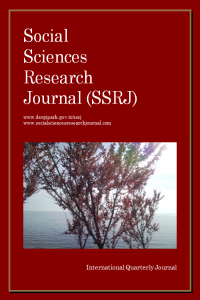Ruminasyon ve Varsayılan Mod Ağı (DMN): Bir Beyin Ağı İncelemesi
ruminasyon, kara kara düşünme, yansıtma, olumsuz düşünme örüntüsü, f-MRI, varsayılan mod ağı
Rumination and Default Mode Network (DMN): A Brain Network Review
rumination, brooding, reflection, negative thinking pattern, f-MRI, default mode network,
___
- American Psychiatric Association. 2013. DSM-5. Diagnostic and statistical manual of mental disorders (5th Edition). Washington, DC: American Psychiatric Association. https://doi.org/10.1176/appi.books.9780890425596
- Brennan, K., Barnhofer, T., Crane, C., Duggan, D., & Williams, J. M. (2015). Memory specificity and mindfulness jointly moderate the effect of reflective pondering on depressive symptoms in individuals with a history of recurrent depression. Journal of Abnormal Psychology, 124 (2), 246–255.
- Buckner, R.L., Andrews-Hanna, J.R., Schacter, D.L. (2008). The brain’s default network: anatomy, function, and relevance to disease. Annals of the New York Academy of Sciences, 1124, 1–38.
- Cavanna, A.E., Trimble, M.R. (2006). The precuneus: a review of its functional anatomy and behavioural correlates. Brain, 129 (3), 564–583.
- Ehring, T.; Watkins, E.R. (2008). Repetitive negative thinking as a transdiagnostic process. International Journal of Cognitive Therapy, 1:192-205.
- Hamilton, J.P., Furman, D.J., Chang, C., Thomason, M.E., Dennis, E., Gotlib, I.H. (2011). Default-mode and task-positive network activity in major depressive disorder: implications for adaptive and maladaptive rumination. Biological Psychiatry, 70 (4), 327–33.
- Jacobs, R.H., et al. (2016). Targeting ruminative thinking in adolescents at risk for depressive relapse: rumination-focused cognitive behavior therapy in a pilot randomized controlled trial with resting state fMRI. PLoS One 11.
- Jacob, Y., et al. (2020). Neural correlates of rumination in major depressive disorder: A brain network analysis. NeuroImage: Clinical 25, 1021-1042.
- Johnson, D. P., & Whisman, M. A. (2013). Gender differences in rumination: A meta-analysis. Personality and Individual Differences, 55 (4), 367–374.
- Johnson, M.K., Nolen-Hoeksema, S., Mitchell, K.J., Levin, Y. (2009). Medial cortex activity, self-reflection and depression. Social Cognitive and Affective Neuroscience, 4 (4), 313–27.
- Kuhn, S., Vanderhasselt, M.A., De Raedt, R., Gallinat, J. (2014). The neural basis of unwanted thoughts during resting state. Social Cognitive and Affective Neuroscience, 9 (9), 1320–4.
- Lois, G. & Wessa, M. (2016). Differential association of default mode network connectivity and rumination in healthy individuals and remitted MDD patients. Social Cognitive and Affective Neuroscience, 1792–1801.
- Lyubomirsky, S., Caldwell, N.D., & Nolen-Hoeksema, S. (1998). Effects of Ruminative and Distracting Responses to Depressed Mood on Retrieval of Autobiographical Memories. Journal of Personality and Social Psychology, 75, 166-177.
- Lyubomirsky, S., Layous, K., Bay, E., Chancellor, J., Nelson-coffey, S.K. (2015). Thinking About Rumination: The Scholarly Contributions and Intellectual Legacy of Susan Nolen-Hoeksema.
- Nolen-Hoeksema, S. (1991). Responses to depression and their effects on the duration of depressive episodes. Journal of Abnormal Psychology, 10, 569–582.
- Nolen-Hoeksema, S., Wisco, B.E., Lyubomirsky, S. (2008). Rethinking rumination. Perspectives on Psychological Science 3 (5), 400–24.
- Northoff, G. & Bermpohl, F. (2004) Cortical midline structures and the self. Trends Cogn. Sci. 8, 102–107.
- Ordaz, S.J., et al. (2016). Ruminative brooding is associated with salience network coherence in early pubertal youth. Social Cognitive and Affective Neuroscience, 298–310.
- Raichle ME, Snyder AZ (2007) A default mode of brain function: a brief history of an evolving idea. Neuroimage 37(4):1083-1090.
- Satyshur, M., D.; Layden, E., A.; Gowins, J., R.; Buchanan, A. & Gollan, J., K. (2018). Functional connectivity of reflective and brooding rumination in depressed and healthy women. Cognitive, Affective, & Behavioral Neuroscience, 18, 884–901.
- Shulman, G. L., Fiez, J. A., Corbetta, M., Buckner, R. L., Miezin, F. M., et al. (1997). Common blood flow changes acrossvisual tasks: II.: decreases in cerebral cortex. Journal of Cognitive Neuroscience, 9, 648–63.
- Southworth, F., Grafton, B., MacLeod, C., Watkins, E. (2017). Heightened ruminative disposition is associated with impaired attentional disengagement from negative relative to positive information: support for the “impaired disengagement” hypothesis. Cognitive Emotion 31, 422–434.
- Treynor, W., Gonzalez, R., Nolen-Hoeksema, S. (2003). Rumination reconsidered: A psychometric analaysis. Cognitive Therapy and Research, 27 (3), 247–259.
- Zhou HX, Chen X, Shen YQ, Li L, Chen NX, Zhu ZC, Castellanos FX, Yan CG. 2019. Rumination and the default mode network: Meta-analysis of brain imaging studies and implications for depression. Neuroimage, 116-287.
- Zhu, X.; Zhu, Q.; Shen, H.; Liao, W. & Yuan, F. (2017). Rumination and Default Mode Network Subsystems Connectivity in First-episode, Drug-Naive Young Patients with Major Depressive Disorder. Scientific Reports, 7, 43105.
- Yayın Aralığı: Yılda 4 Sayı
- Yayıncı: Denta Florya ADSM Limited Company
Dilek ÇİFTCİ BAYKAL, Funda KARDAŞ ÖZDEMİR, Kerime Derya BEYDAĞ
Vahdet ÖZKOÇAK, Ali Murat KIRIK
Ruminasyon ve Varsayılan Mod Ağı (DMN): Bir Beyin Ağı İncelemesi
Buket KOÇYİĞİT OCAK, Emel ERDOĞDU
Grafik Tasarımda Etik Sorunlar: Akademisyen Görüşleri
Ayşegül GÜRDAL PAMUKLU, Melike BAKAR FINDIKCI
Majör Depresyon ve Tükenmişlik: Bir Olgu Sunumu
Sektörel Tahminleme Amaçlı Satınalma Yöneticileri Endeksi Üzerine Bir Literatür Taraması
Etik Satış Davranışının Müşteri Sadakatine Etkisi
